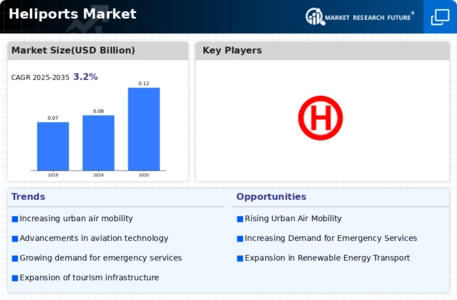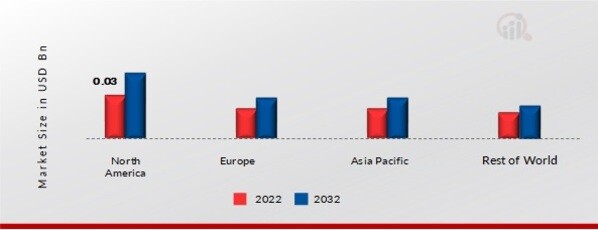-
EXECUTIVE SUMMARY
-
MARKET INTRODUCTION
-
Definition
-
Scope of the Study
- Research Objective
- Assumptions
- Limitations
-
RESEARCH METHODOLOGY
-
Overview
-
Data Mining
-
Secondary Research
-
Primary Research
- Primary Interviews and Information Gathering Process
- Breakdown of Primary Respondents
-
Forecasting Model
-
Market Size Estimation
- Bottom-Up Approach
- Top-Down Approach
-
Data Triangulation
-
Validation
-
MARKET DYNAMICS
-
Overview
-
Drivers
-
Restraints
-
Opportunities
-
MARKET FACTOR ANALYSIS
-
Value Chain Analysis
-
Porter’s Five Forces Analysis
- Bargaining Power of Suppliers
- Bargaining Power of Buyers
- Threat of New Entrants
- Threat of Substitutes
- Intensity of Rivalry
-
COVID-19 Impact Analysis
- Market Impact Analysis
- Regional Impact
- Opportunity and Threat Analysis
-
GLOBAL HELIPORTS MARKET, BY TYPE
-
Overview
-
Land-based Heliports
-
Water-based Heliports
-
GLOBAL HELIPORTS MARKET, BY PRODUCT TYPE
-
Overview
-
Surface Level Heliports
-
Rooftop Heliports
-
Elevated Heliports
-
GLOBAL HELIPORTS MARKET, BY MODE OF OPERATION
-
Overview
-
PORTABLE
-
Fixed
-
GLOBAL HELIPORTS MARKET, BY END-USE
-
Overview
-
Commercial
-
Private
-
Public
-
Ambulance
-
GLOBAL HELIPORTS MARKET, BY REGION
-
Overview
-
North America
- US
- Canada
-
Europe
- Germany
- France
- UK
- Italy
- Spain
- Rest of Europe
-
Asia-Pacific
- China
- India
- Japan
- South Korea
- Australia
- Rest of Asia-Pacific
-
Rest of the World
- Middle East
- Africa
- Latin America
-
COMPETITIVE LANDSCAPE
-
Overview
-
Competitive Analysis
-
Market Share Analysis
-
Major Growth Strategy in the Global Heliports Market,
-
Competitive Benchmarking
-
Leading Players in Terms of Number of Developments in the Global Heliports Market,
-
Key developments and Growth Strategies
- New Product Launch/Service End-Use
- Merger & Acquisitions
- Joint Ventures
-
Major Players Financial Matrix
- Sales & Operating Income, 2025
- Major Players R&D Expenditure. 2025
-
COMPANY PROFILES
-
AB Aluminium Offshore Pte Ltd
- Company Overview
- Financial Overview
- Products Offered
- Key Developments
- SWOT Analysis
- Key Strategies
-
Bnnaviation
- Company Overview
- Financial Overview
- Products Offered
- Key Developments
- SWOT Analysis
- Key Strategies
-
FEC Heliports
- Company Overview
- Financial Overview
- Products Offered
- Key Developments
- SWOT Analysis
- Key Strategies
-
Helidex LLC
- Company Overview
- Financial Overview
- Products Offered
- Key Developments
- SWOT Analysis
- Key Strategies
-
Heliport Systems Inc
- Company Overview
- Financial Overview
- Products Offered
- Key Developments
- SWOT Analysis
- Key Strategies
-
Helitecnica
- Company Overview
- Financial Overview
- Products Offered
- Key Developments
- SWOT Analysis
- Key Strategies
-
Technokontrol Global Ltd
- Company Overview
- Financial Overview
- Products Offered
- Key Developments
- SWOT Analysis
- Key Strategies
-
APPENDIX
-
References
-
Related Reports
-
-
LIST OF TABLES
-
GLOBAL HELIPORTS MARKET, SYNOPSIS, 2018-2032
-
GLOBAL HELIPORTS MARKET, ESTIMATES & FORECAST, 2025 -2034(USD BILLION)
-
GLOBAL HELIPORTS MARKET, BY TYPE, 2025 -2034(USD BILLION)
-
GLOBAL HELIPORTS MARKET, BY PRODUCT TYPE, 2025 -2034(USD BILLION)
-
GLOBAL HELIPORTS MARKET, BY MODE OF OPERATION, 2025 -2034(USD BILLION)
-
GLOBAL HELIPORTS MARKET, BY END-USE, 2025 -2034(USD BILLION)
-
NORTH AMERICA: HELIPORTS MARKET, BY TYPE, 2025 -2034(USD BILLION)
-
NORTH AMERICA: HELIPORTS MARKET, BY PRODUCT TYPE, 2025 -2034(USD BILLION)
-
NORTH AMERICA: HELIPORTS MARKET, BY MODE OF OPERATION, 2025 -2034(USD BILLION)
-
NORTH AMERICA: HELIPORTS MARKET, BY END-USE, 2025 -2034(USD BILLION)
-
US: HELIPORTS MARKET, BY TYPE, 2025 -2034(USD BILLION)
-
US: HELIPORTS MARKET, BY PRODUCT TYPE, 2025 -2034(USD BILLION)
-
US: HELIPORTS MARKET, BY MODE OF OPERATION, 2025 -2034(USD BILLION)
-
US: HELIPORTS MARKET, BY END-USE, 2025 -2034(USD BILLION)
-
CANADA: HELIPORTS MARKET, BY TYPE, 2025 -2034(USD BILLION)
-
CANADA: HELIPORTS MARKET, BY PRODUCT TYPE, 2025 -2034(USD BILLION)
-
CANADA: HELIPORTS MARKET, BY MODE OF OPERATION, 2025 -2034(USD BILLION)
-
CANADA: HELIPORTS MARKET, BY END-USE, 2025 -2034(USD BILLION)
-
EUROPE: HELIPORTS MARKET, BY TYPE, 2025 -2034(USD BILLION)
-
EUROPE: HELIPORTS MARKET, BY PRODUCT TYPE, 2025 -2034(USD BILLION)
-
EUROPE: HELIPORTS MARKET, BY MODE OF OPERATION, 2025 -2034(USD BILLION)
-
EUROPE: HELIPORTS MARKET, BY END-USE, 2025 -2034(USD BILLION)
-
GERMANY: HELIPORTS MARKET, BY TYPE, 2025 -2034(USD BILLION)
-
GERMANY: HELIPORTS MARKET, BY PRODUCT TYPE, 2025 -2034(USD BILLION)
-
GERMANY: HELIPORTS MARKET, BY MODE OF OPERATION, 2025 -2034(USD BILLION)
-
GERMANY: HELIPORTS MARKET, BY END-USE, 2025 -2034(USD BILLION)
-
FRANCE: HELIPORTS MARKET, BY TYPE, 2025 -2034(USD BILLION)
-
FRANCE: HELIPORTS MARKET, BY PRODUCT TYPE, 2025 -2034(USD BILLION)
-
FRANCE: HELIPORTS MARKET, BY MODE OF OPERATION, 2025 -2034(USD BILLION)
-
FRANCE: HELIPORTS MARKET, BY END-USE, 2025 -2034(USD BILLION)
-
ITALY: HELIPORTS MARKET, BY TYPE, 2025 -2034(USD BILLION)
-
ITALY: HELIPORTS MARKET, BY PRODUCT TYPE, 2025 -2034(USD BILLION)
-
ITALY: HELIPORTS MARKET, BY MODE OF OPERATION, 2025 -2034(USD BILLION)
-
ITALY: HELIPORTS MARKET, BY END-USE, 2025 -2034(USD BILLION)
-
SPAIN: HELIPORTS MARKET, BY TYPE, 2025 -2034(USD BILLION)
-
SPAIN: HELIPORTS MARKET, BY PRODUCT TYPE, 2025 -2034(USD BILLION)
-
SPAIN: HELIPORTS MARKET, BY MODE OF OPERATION, 2025 -2034(USD BILLION)
-
SPAIN: HELIPORTS MARKET, BY END-USE, 2025 -2034(USD BILLION)
-
UK: HELIPORTS MARKET, BY TYPE, 2025 -2034(USD BILLION)
-
UK: HELIPORTS MARKET, BY PRODUCT TYPE, 2025 -2034(USD BILLION)
-
UK: HELIPORTS MARKET, BY MODE OF OPERATION, 2025 -2034(USD BILLION)
-
UK: HELIPORTS MARKET, BY END-USE, 2025 -2034(USD BILLION)
-
REST OF EUROPE: HELIPORTS MARKET, BY TYPE, 2025 -2034(USD BILLION)
-
REST OF EUROPE: HELIPORTS MARKET, BY PRODUCT TYPE, 2025 -2034(USD BILLION)
-
REST OF EUROPE: HELIPORTS MARKET, BY MODE OF OPERATION, 2025 -2034(USD BILLION)
-
REST OF EUROPE: HELIPORTS MARKET, BY END-USE, 2025 -2034(USD BILLION)
-
ASIA-PACIFIC: HELIPORTS MARKET, BY TYPE, 2025 -2034(USD BILLION)
-
ASIA-PACIFIC: HELIPORTS MARKET, BY PRODUCT TYPE, 2025 -2034(USD BILLION)
-
ASIA-PACIFIC: HELIPORTS MARKET, BY MODE OF OPERATION, 2025 -2034(USD BILLION)
-
ASIA-PACIFIC: HELIPORTS MARKET, BY END-USE, 2025 -2034(USD BILLION)
-
JAPAN: HELIPORTS MARKET, BY TYPE, 2025 -2034(USD BILLION)
-
JAPAN: HELIPORTS MARKET, BY PRODUCT TYPE, 2025 -2034(USD BILLION)
-
JAPAN: HELIPORTS MARKET, BY MODE OF OPERATION, 2025 -2034(USD BILLION)
-
JAPAN: HELIPORTS MARKET, BY END-USE, 2025 -2034(USD BILLION)
-
CHINA: HELIPORTS MARKET, BY TYPE, 2025 -2034(USD BILLION)
-
CHINA: HELIPORTS MARKET, BY PRODUCT TYPE, 2025 -2034(USD BILLION)
-
CHINA: HELIPORTS MARKET, BY MODE OF OPERATION, 2025 -2034(USD BILLION)
-
CHINA: HELIPORTS MARKET, BY END-USE, 2025 -2034(USD BILLION)
-
INDIA: HELIPORTS MARKET, BY TYPE, 2025 -2034(USD BILLION)
-
INDIA: HELIPORTS MARKET, BY PRODUCT TYPE, 2025 -2034(USD BILLION)
-
INDIA: HELIPORTS MARKET, BY MODE OF OPERATION, 2025 -2034(USD BILLION)
-
INDIA: HELIPORTS MARKET, BY END-USE, 2025 -2034(USD BILLION)
-
AUSTRALIA: HELIPORTS MARKET, BY TYPE, 2025 -2034(USD BILLION)
-
AUSTRALIA: HELIPORTS MARKET, BY PRODUCT TYPE, 2025 -2034(USD BILLION)
-
AUSTRALIA: HELIPORTS MARKET, BY MODE OF OPERATION, 2025 -2034(USD BILLION)
-
AUSTRALIA: HELIPORTS MARKET, BY END-USE, 2025 -2034(USD BILLION)
-
SOUTH KOREA: HELIPORTS MARKET, BY TYPE, 2025 -2034(USD BILLION)
-
SOUTH KOREA: HELIPORTS MARKET, BY PRODUCT TYPE, 2025 -2034(USD BILLION)
-
SOUTH KOREA: HELIPORTS MARKET, BY MODE OF OPERATION, 2025 -2034(USD BILLION)
-
SOUTH KOREA: HELIPORTS MARKET, BY END-USE, 2025 -2034(USD BILLION)
-
REST OF ASIA-PACIFIC: HELIPORTS MARKET, BY TYPE, 2025 -2034(USD BILLION)
-
REST OF ASIA-PACIFIC: HELIPORTS MARKET, BY PRODUCT TYPE, 2025 -2034(USD BILLION)
-
REST OF ASIA-PACIFIC: HELIPORTS MARKET, BY MODE OF OPERATION, 2025 -2034(USD BILLION)
-
REST OF ASIA-PACIFIC: HELIPORTS MARKET, BY END-USE, 2025 -2034(USD BILLION)
-
REST OF THE WORLD: HELIPORTS MARKET, BY TYPE, 2025 -2034(USD BILLION)
-
REST OF THE WORLD: HELIPORTS MARKET, BY PRODUCT TYPE, 2025 -2034(USD BILLION)
-
REST OF THE WORLD: HELIPORTS MARKET, BY MODE OF OPERATION, 2025 -2034(USD BILLION)
-
REST OF THE WORLD: HELIPORTS MARKET, BY END-USE, 2025 -2034(USD BILLION)
-
MIDDLE EAST: HELIPORTS MARKET, BY TYPE, 2025 -2034(USD BILLION)
-
MIDDLE EAST: HELIPORTS MARKET, BY PRODUCT TYPE, 2025 -2034(USD BILLION)
-
MIDDLE EAST: HELIPORTS MARKET, BY MODE OF OPERATION, 2025 -2034(USD BILLION)
-
MIDDLE EAST: HELIPORTS MARKET, BY END-USE, 2025 -2034(USD BILLION)
-
AFRICA: HELIPORTS MARKET, BY TYPE, 2025 -2034(USD BILLION)
-
AFRICA: HELIPORTS MARKET, BY PRODUCT TYPE, 2025 -2034(USD BILLION)
-
AFRICA: HELIPORTS MARKET, BY MODE OF OPERATION, 2025 -2034(USD BILLION)
-
AFRICA: HELIPORTS MARKET, BY END-USE, 2025 -2034(USD BILLION)
-
LATIN AMERICA: HELIPORTS MARKET, BY TYPE, 2025 -2034(USD BILLION)
-
LATIN AMERICA: HELIPORTS MARKET, BY PRODUCT TYPE, 2025 -2034(USD BILLION)
-
LATIN AMERICA: HELIPORTS MARKET, BY MODE OF OPERATION, 2025 -2034(USD BILLION)
-
LATIN AMERICA: HELIPORTS MARKET, BY END-USE, 2025 -2034(USD BILLION)
-
LIST OF FIGURES
-
RESEARCH PROCESS
-
MARKET STRUCTURE FOR THE GLOBAL HELIPORTS MARKET
-
MARKET DYNAMICS FOR THE GLOBAL HELIPORTS MARKET
-
GLOBAL HELIPORTS MARKET, SHARE (%), BY TYPE, 2025
-
GLOBAL HELIPORTS MARKET, SHARE (%), BY PRODUCT TYPE, 2025
-
GLOBAL HELIPORTS MARKET, SHARE (%), BY MODE OF OPERATION, 2025
-
GLOBAL HELIPORTS MARKET, SHARE (%), BY END-USE, 2025
-
GLOBAL HELIPORTS MARKET, SHARE (%), BY REGION, 2025
-
NORTH AMERICA: HELIPORTS MARKET, SHARE (%), BY REGION, 2025
-
EUROPE: HELIPORTS MARKET, SHARE (%), BY REGION, 2025
-
ASIA-PACIFIC: HELIPORTS MARKET, SHARE (%), BY REGION, 2025
-
REST OF THE WORLD: HELIPORTS MARKET, SHARE (%), BY REGION, 2025
-
GLOBAL HELIPORTS MARKET: COMPANY SHARE ANALYSIS, 2025 (%)
-
AB ALUMINIUM OFFSHORE PTE LTD: FINANCIAL OVERVIEW SNAPSHOT
-
AB ALUMINIUM OFFSHORE PTE LTD: SWOT ANALYSIS
-
BNNAVIATION: FINANCIAL OVERVIEW SNAPSHOT
-
BNNAVIATION: SWOT ANALYSIS
-
FEC HELIPORTS.: FINANCIAL OVERVIEW SNAPSHOT
-
FEC HELIPORTS.: SWOT ANALYSIS
-
HELIDEX LLC: FINANCIAL OVERVIEW SNAPSHOT
-
HELIDEX LLC: SWOT ANALYSIS
-
HELIPORT SYSTEMS INC.: FINANCIAL OVERVIEW SNAPSHOT
-
HELIPORT SYSTEMS INC..: SWOT ANALYSIS
-
HELITECNICA: FINANCIAL OVERVIEW SNAPSHOT
-
HELITECNICA: SWOT ANALYSIS
-
TECHNOKONTROL GLOBAL LTD: FINANCIAL OVERVIEW SNAPSHOT
-
TECHNOKONTROL GLOBAL LTD: SWOT ANALYSIS





Leave a Comment